|


DOGS
MUSHERS
BEGINNERS
BOOKSTORE
FANS
FEATURES
FIND IT
LINKS
ONAC
RESOURCES

RACING

TRAINING
FUN
SDC
|

|
Pre-Columbian Tribal
Dogs In The Americas

by Stephanie Little Wolf
~Click photos for larger view~
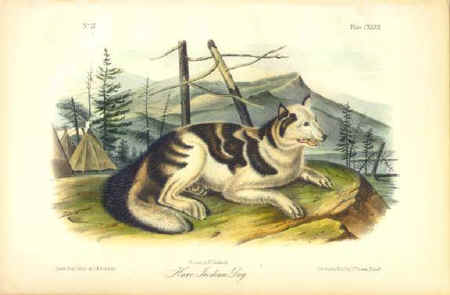
Hare Indian Dog - Audubon
The dog who first entered North America with paleoindians was a well
established inhabitant along with his human counterpart as early as fourteen thousand
years ago. DNA studies on the genetic structure of paleoamerican dogs show that this was a
fully domesticated animal at the time of entry into the North American continent,
suggesting that the domestication of dogs occurred at an earlier time than has been
previously suggested, (the archaeological record suggests canid domestication events
around fourteen thousand years ago)- about the same time that humans walked over from
Eurasia to the new world. This would indicate that the dog was actually domesticated at an
earlier time than that.
The DNA Factor
Indeed, the Mtdna (mitochondrial) studies strongly support the hypothesis that
paleoamerican and Eurasian domestic dogs share a common origin, both evolving from the
Eurasian gray Wolf. No evidence of a separate domestication of dogs from North American
Grey Wolves was discovered. Although the haplotypes found in paleoamerican dogs were
closely related to Eurasian dogs, some of them formed a unique clad within the main
genetic group, (clad 1), which is found only in paleoamerican dogs. This indicates that
dogs were present and isolated in the new world for a considerable amount of time. This
long period of isolation led to the appearance of a group of genetic sequences
(haplotypes) that are similar but very easily distinguishable from dogs from other parts
of the world, or from any modern dog population in America today. Indeed, no surveyed
modern population of dogs in the United States carries these unique genetic markers in
their DNA. American Indian Dogs were extinct early on by the inbreeding and replacement by
European dogs. Only the Eskimo dog has survived. Dna evidence links the Eskimo Dog with
the Australian Dingo, the New Guinea Singing dog, and the Shiba Inu. The Mexican Hairless
or Xoloitzcuintle was present in the Americas long before Europeans arrived, but the
genetic lineage shows extreme mixing with European dogs and may not genetically resemble
its pre-Columbian ancestors anymore, although reduced dentition and hairlessness are
extremely dominant traits, so the dogs strongly resemble their forbears in appearance.
Dogs, Wolves, and Coyotes
At the time of European contact, American Indians were groups of diverse and
widely dispersed nations. It is common yet inaccurate these days for them to be discussed
as one single population and their dogs do not escape this inaccuracy. In fact, there were
many different types of Indian dogs and they were used for a variety of reasons that were
as diverse and unique as the people they inhabited the land with. It is also common for
modern researchers to site early explorers from the late 1600's to the late 1800's and
their anecdotal interpretations of Indian dogs as being almost impossible to distinguish
from the wolf. This is also a common mistake and misinterpretation today. Countless times
I have heard children, and adults refer to my Alaskan Village dogs as wolves. In fact,
Eskimo dogs, huskies and other sled dogs may have fur and vocalizations that resemble
their wolf ancestors, but that is about it. Dogs have a shorter stockier build, wider
chests and shorter faces and muzzles, with short steep "stops" or angle from
forehead to the bridge of the nose.
In all, many dogs filled rolls within Indian cultures. Some tribes had rather loose
associations with their dogs, some were extremely attached and involved with dogs as pets
and or using them for various tasks. Dogs probably tracked game, and packed meat after a
hunt. Dogs were eaten by some groups as a food source and some were only consumed
ceremonially. Dogs were the playmates of young children and companions to the elders.
Four distinct types of tribal dog are presented here, although many more existed at one
time. I encourage one to carefully review the list of resources presented at the end of
this article.
Great Plains Dogs
Dogs were an integral and important aspect of the tribes they were a part of. It
is logical to discuss "dog culture" as the time period before the acquisition of
the horse, and the time after this acquisition as "horse culture" by nations of
the Great Plains. Some dogs were used for hauling and packing, pulling the famous travois
across the plains. They packed meat or belongings, children and the elderly. They were
pets, a food source, and possible trackers of game. They were numerous, partly fended for
themselves, and bred freely with little input or selectiveness from tribal people.
Selective breeding most likely did not occur among plains tribes, the only intervention in
this respect was the culling of small or sickly pups or those that were snappish or surly
with small children. Culling was also practiced to reduce the load of pups on the mother
so she retained her health during the nursing period, and to select for large heavily
boned individuals. Dogs served the important function of barking to alarm the tribe of the
approach of enemies or visitors.
Large and medium sized dogs coexisted and are sometimes vicariously referred to as
Plains Indian Dogs and Sioux Dogs. These dogs according to some descriptions were either
Dingo tawny colored and short or smooth coated, or grayish and somewhat longer coated.
Many other color combinations existed, however, such as white, black, spotted and mottled.
In reading many of the descriptions, what comes across is an animal somewhat like a dingo
and somewhat like a husky. Tails were either short, broom or half tails, or sickle shaped
with the typical curve of many a pariah dog throughout the world today. Photographs that
exist of plains Indians and dogs show extremely mixed individuals, in recreated scenes
that tried to depict a lifestyle well after cultural demise. The dogs bear the mark of
European breeds, in color, coat texture; many possessing the typical heavier flopped over
ears.
The Tahl Tan Bear Dog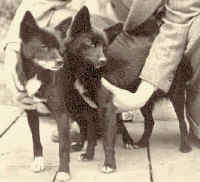
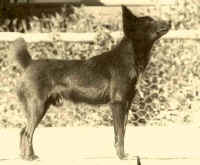 This little bear
dog was from 12 to 18 inches tall and weighed from 10- to 18lbs. Amazingly, It survived
into the late 1960's or early 70's. This dog of the Tlingits, Tahltans, Kaska, and Sekani
was used for hunting bears in British Columbia, Canada. The hunters carried the dog inside
a pouch until bear tracks were discovered, where upon the dogs tracked the bear. These
small dogs could run on top of crusty snow and bark and worry the bear until hunters
arrived. These little dogs were black with white markings, or white with black markings,
not much bigger that today's Schipperke. On examining a photograph from Atlin, B.C., of a
bear dog, I noticed its resemblance to the New Guinea Singing Dog, an extremely rare dingo
type dog from Papua New Guinea. In another photograph, the dog resembled a Papillion. This little bear
dog was from 12 to 18 inches tall and weighed from 10- to 18lbs. Amazingly, It survived
into the late 1960's or early 70's. This dog of the Tlingits, Tahltans, Kaska, and Sekani
was used for hunting bears in British Columbia, Canada. The hunters carried the dog inside
a pouch until bear tracks were discovered, where upon the dogs tracked the bear. These
small dogs could run on top of crusty snow and bark and worry the bear until hunters
arrived. These little dogs were black with white markings, or white with black markings,
not much bigger that today's Schipperke. On examining a photograph from Atlin, B.C., of a
bear dog, I noticed its resemblance to the New Guinea Singing Dog, an extremely rare dingo
type dog from Papua New Guinea. In another photograph, the dog resembled a Papillion.
The Eskimo, or Inuit Dog of Canada, Alaska, and Greenland: The Qimmiq
Today, the Eskimo dog thankfully is alive and well. It originally occupied the
coastal and archipelago areas of Greenland, Alaska, and Canada. Once upon a time, today's
Malamute fell into the Eskimo dog category, the indigenous dog of the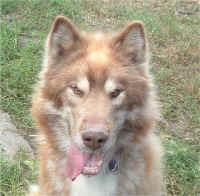 Mahlemuit Eskimos from the Kotzebue Sound area in
Alaska. The Eskimo dog was a puller of sleds, used for hauling heaving loads of fish,
whale, and seal or walrus from the hunt to the village or camp. In the summer, backpacking
was the traditional use of the dog. The dogs are bigger and more heavily boned than
Siberian Huskies, which are not native to North America. They could and can work in the
most hostile of environments with little food or care. They are friendly for the most part
but fight with each other to establish the ritual pecking order. They are primitive
compared to most modern breeds, as they don't bark as much and howl often. They have heavy
winter coats and range from as small as 45 lbs for females to as large as 85lbs for males,
sexual dimorphism being related to more primitive qualities. An Eskimo dog's fur or pelage
takes many colors, but the eyes should not be blue and there is some controversy here.
These dogs are challenging to work with and are strong beyond belief with incredible
stamina. They are known in modern times as The Canadian Inuit Dog, The Inuit sled dog, and
the Greenlander or Greenland dog. Clubs and organizations today are strong enthusiasts for
the Eskimo dog, getting together and employing the old style fan hitch to go dog sledding
or the modern tandem hitch for those of us who have narrow forest trails. Mahlemuit Eskimos from the Kotzebue Sound area in
Alaska. The Eskimo dog was a puller of sleds, used for hauling heaving loads of fish,
whale, and seal or walrus from the hunt to the village or camp. In the summer, backpacking
was the traditional use of the dog. The dogs are bigger and more heavily boned than
Siberian Huskies, which are not native to North America. They could and can work in the
most hostile of environments with little food or care. They are friendly for the most part
but fight with each other to establish the ritual pecking order. They are primitive
compared to most modern breeds, as they don't bark as much and howl often. They have heavy
winter coats and range from as small as 45 lbs for females to as large as 85lbs for males,
sexual dimorphism being related to more primitive qualities. An Eskimo dog's fur or pelage
takes many colors, but the eyes should not be blue and there is some controversy here.
These dogs are challenging to work with and are strong beyond belief with incredible
stamina. They are known in modern times as The Canadian Inuit Dog, The Inuit sled dog, and
the Greenlander or Greenland dog. Clubs and organizations today are strong enthusiasts for
the Eskimo dog, getting together and employing the old style fan hitch to go dog sledding
or the modern tandem hitch for those of us who have narrow forest trails.
The West Coast Salish, Little woolly Dog or Clallam Indian Dog
These dogs were restricted to a fairly distinct area of northern British
Columbia, where they were kept on islands to keep them from breeding with other types of
dogs. The responsibility of woman, they were small, somewhat larger than todays
Pomeranian. They had had a long thick mostly white pelage which was harvested by the
Salish Indians to make clothing and blankets from. The dogs were numerous and highly
utilized. Vancouver recorded that the dogs were shorn to the skin like sheep, and that the
shorn wool of the dogs was so thick, that large mats of it could be lifted without being
pulled apart. The wool of these dogs was dyed red or blue and striped blankets of cedar
strips and dog wool were hardy and warm. The Artist Paul Kane gives us a wonderful and
lengthy description of how the dog wool was made into blankets using cedar and white
earth, apparently twisted together a beaten mixture of these, then rolling them down the
leg as if twisting twine or yarn, then sewing the strips together.
Other Native American Dogs
There were many other dogs of North and South America. The Peruvian Pug-nosed
dog, the Feugian dog, the Inca dogs, the Xoloytzecuintli, or Mexican hairless dog, the
Hare Indian dog of the north, the Short Nosed dogs of the southwest, to name just a few.
It is sad that most of these dogs are gone, with the exception of the Xolo, and Mexican
Hairless. I have acquired photographs of Mayan dogs and they may resemble original Mayan
dogs somewhat in their similarity to pariah type or aboriginal dogs from other parts of
the world.
The Archaeological record tells us that native pre-Columbian dogs were often buried
with their owners, and at other times, given their own intricate burials. They disappeared
rapidly, and with good cause, unable as their owners were to withstand European dog
diseases, and probably shot as a matter of course for their attention to European
livestock. On the east coast among the original colonies of America, Indian dogs were
outlawed and it was a crime for villages to possess them, as it was firearms. One needs
only compare the demise of the pure Australian Dingo as a model for how fast native dogs
disappeared from north, central, and South America. In Australia, only small pockets of
genetically pure Dingoes remain, and they are threatened. One can openly imagine how fast
North American dogs became amalgamated from their pure forms, and then disappeared
entirely from the lives of a people whose own lives became increasingly difficult. It was
all tribal nations could do to manage their own fates in the face of rapid decimation.
Unlike the Dingo, dogs of the Americas had no wild populations from which to replenish
their numbers. In their absence, we must turn to scientific research and learn what we can
about this fascinating subject.
Resources on Native American Dogs
Studying modern aboriginal dogs such as the Dingo, the Santal Hound, and the New
Guinea Singing dogs may shed some light on the relationship between native tribal peoples
and their dogs. Following, is a list of resources which reveals a wonderful and
interesting topic of study. In addition to these sources, I encourage one to study the
works of R.K. Wayne, Jennifer Leonard, Susan Crockford, I. Lehr Brisbin, Janice Koler
-Matznik, and Bulu Imam.
1) Leonard J. A., R. K. Wayne, J. Wheeler, R.
Valadez, S. Guillén and C. Vilà.
Ancient DNA evidence for Old World origin of New World dogs.
Science 2002; 298:1613-1616.
2) Dogs of the American Aborigines- Allen, Glover
Bulletin of the Museum pf Comparative Zoology, Harvard College
Vol. 43, #9
Cambridge, Mass, 1920
3) Dogs of the Northeastern Indians, Butler and Hancock
Mass. Archaeological Society Bulletin
vol. 10, #2
pages 17-35, 1949
4) From Dogs to Horses among the Western Indian Tribes, F. G. Roe,
Transactions, royal Society of Canada, third series, Volume xxx111
1939
5) A History of Dogs of the Early Americas,
By M.Schwartz Yale University Press
1979
6) Lost History of the Canine Race
M.E. Thurston, chapter 7
"The Other Americans"
(page 146)
Andrews and McMeel, 1996
7) First Nations, First Dogs
B.D. Cummins, Canadian Ethnocynolgy
Destilig Enterprises, Alberta Canada, 2002
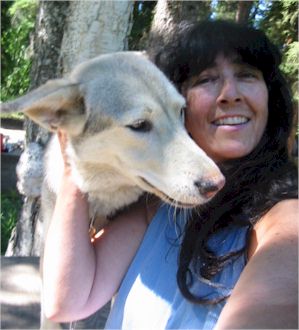 Stephanie Little Wolf is a singer, songwriter, poet and
research technician. She attended Cabrillo Junior College, and graduated from The
University of California, Santa Cruz in 1996. Stephanie Little Wolf is a singer, songwriter, poet and
research technician. She attended Cabrillo Junior College, and graduated from The
University of California, Santa Cruz in 1996.
Her studies and interests include DNA research, Anthropology, Archeology, and
Sociology, pre-Columbian life in North America and the development and domestication of
the dog in prehistory.
She has lived and worked in Alaska for many years, preserving her family's
bloodline of sled dogs which she inherited in 1989.
She has worked with Native Alaskan foster children and her sled dogs, developing a
healing environment for abused and neglected children as they learn to care for and run
sled dogs.
In addition to her work with children and dogs, Stephanie has worked with Native
non-profit organizations in Alaska to preserve Athabascan culture and language, and has
followed this up with a pocket dictionary project at the Alaskan Native Language Center,
at the University of Alaska, Fairbanks, where she worked to preserve the Lower Tanana
Dialect of the Athabascan language family.
[back to Features Index]

top of page |
home |
feedback | search

|



